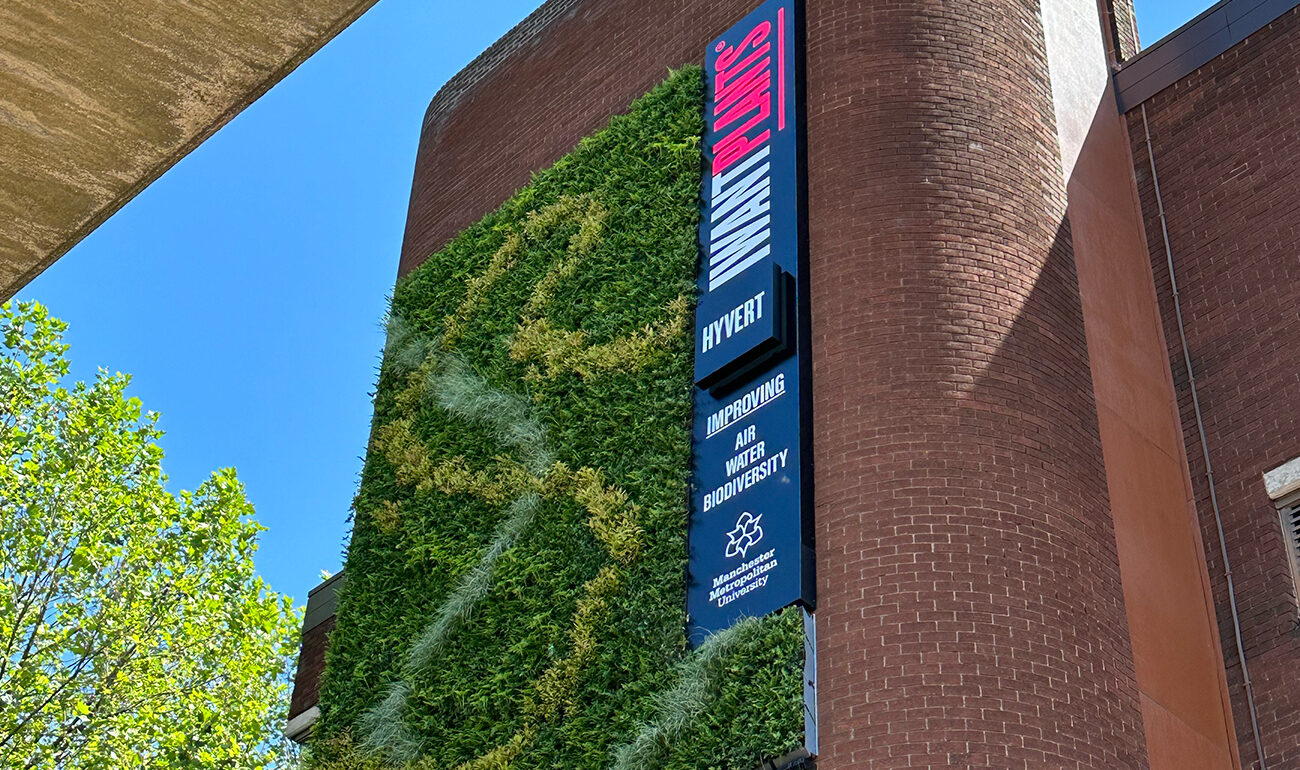Living walls are becoming an increasingly common sight in town, but only one firm guarantees stunning looks with evidence-backed positive environmental impact. Manchester’s Finest headed south of the city to meet I Want Plants – the horticultural design specialist adding greenery to the cityscape, cutting air pollution, and boosting biodiversity – to find out more.
Manchester Metropolitan University, Bruntwood’s Altrincham Foundation Project, No. 2 Circle Square, and Marble Street’s wellbeing-focused office Bloc, Treehouse, Alberts Schloss, Media City, and Australasia – are just some of the different spots where cutting edge biophilic technology and design are tied together by HYVERT.
With many examples already visible across our city, I Want Plants’ HYVERT system is a scalable living wall that transforms building exteriors and interiors – creating a stunning, natural feature rather than glass, steel, brick, or concrete – and has huge environmental benefits. Thanks to a partnership with one of the region’s leading academic institutions, it’s also scientifically verified.
Arriving at their company HQ, on a warm, sunny Thursday, we spend five minutes or so wandering past greenhouses, rows of tall plants, trees, and flowers before finally finding Richard Rowlands. The owner of I Want Plants takes little time to make one thing clear— he’s incredibly passionate about plants. Or perhaps more specifically, biophilic design.

Leaving school at 15 to work with his parents, the founders of the business, back then the firm was instrumental in pioneering a new flora-for-hire model: renting out greenery to spruce up offices, with maintenance included in the deal. “I’ve always been very into design with plants, I love them, I know how they work, what they do, and love that industry. It’s what we’ve always been about. My parents taught me about the importance of plants and considered design and it has been my career and passion ever since,” says Richard.
Skip forward to 2023, Richard, his wife Jessica, who heads up design in the company, and the firm is still well ahead of the industry. Five years in development, HYVERT is now a UK Registered Patent Pending product. Injection molded modules, made from recycled car batteries, are pieced together to create a base in which greenery can be planted, to form an interconnected living wall that can be installed on almost any cladding or material. A living wall which amongst other things, is capable of carbon absorption and considerable energy savings thanks to added insulation by keeping the building cooler in Summer and warmer in Winter.

That’s only half the story, though. If you’ve driven on the Mancunian Way recently, Manchester Metropolitan University now has a HYVERT attached to one of the campus buildings overlooking the flyover. The most significant scientific installation to date, ecology and air quality scientists at the institution (which ranks as one of the UK’s most sustainable universities), are engaged in globally significant research to fully understand the effects and impact of HYVERT.
“We needed the answers, the science of what this system was achieving”, said Richard, when we ask why he entered into a now-three-year-partnership with the university after introductions were made through commercial property giant Bruntwood Group, who are one of I Want Plants’ key clients. We are working together to revolutionise how commercial spaces can be retrofitted with science led vertical green infrastructure.
“I knew what [the system] could do but given the limited research on their environmental benefits we wanted to verify specifically what our HYVERT system could do. For this project, Manchester Metropolitan University has been looking at carbon capture, air pollution and increased energy efficiency but it’s gone much further now. The whole thing is very much about water reutilisation and biodiversity, too.”
“The HYVERT wall on campus collects rainwater which it uses for irrigation. The trace heavy metals that are there, due to pollution, are good for the plants but terrible for rivers, and lakes. So, we are capturing it and feeding the wall with it.
Our initial research has shown an overall 65% reduction of harmful trace metals by using the plants as filters, these metals are things like Lead and Arsenic. Then we are monitoring the building performance with thermal imaging, to see how little energy is escaping on the HYVERT section when compared to the rest.
We’re developing ways of monitoring biodiversity, by recording visiting and nesting species, giving us information on things like how many birds are living there. Now we’ve also started looking at what’s living in the soil.”

Each HYVERT living wall is custom designed to the client’s specifications. For example, a temporary experiment with Manchester’s The Warehouse Project honed in on noise abatement at a live event, trying to understand if plants might improve noise absorption, which turns out is 9.25db.
In contrast, the installation at Manchester Metropolitan University is about quantifying, in precise terms, how those needs can be met. Carbon capture, for example, involves the use of species X. A biodiversity project would require a focus on flowering types, so maybe species B. And for thermal insulation, it might be best to look at species C. The university research is essentially working out the quantities needed in order to achieve exact results. We are building a database unique to HYVERT that can create the perfect green infrastructure for a building.
Richard adds, “It’s a maturing market, but Vertical Green Infrastructure is still a maturing market and a lot of companies before have made assumptions without scientific verification. You can see poor examples in many places which is a shame as it gives the concept a bad name but it’s simply poor design. But a huge amount of work has gone into HYVERT’s design, which hasn’t been easy and has been a case of trial and error, since plants don’t naturally grow in a vertical planting position on the outside of a building. We do feel we have perfected the design now, but our research will continue.”
“I’m not going to get all activist and start preaching at you, but I do genuinely have the desire to do the right thing and it concerns me how bad things are getting. Cities are getting so hot, poor air quality, reduced wildlife habitats, things need to change. We simply don’t have room to plant the trees that we need but all buildings have walls, so we need to view this as an alternative solution. And when you look at plant evolution, how they have been here forever and a day, we can’t keep reducing their space, everything about it is completely wrong so we need to make this change,” he continues, explaining that at least some of these concerns stem from him being a parent, and what the future could look like for younger generations.


